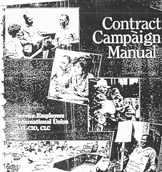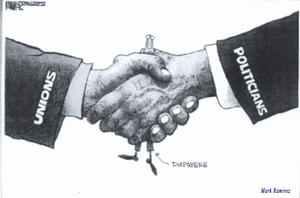Big Labor Scare Tactics
Union bosses have sent out mailers in Oregon claiming that their votes in the upcoming election will not be secret. “Your voting history is a matter of public…

Union bosses have sent out mailers in Oregon claiming that their votes in the upcoming election will not be secret. “Your voting history is a matter of public…
From the Weekly Standard: A GOP source sends along this video, shot by a Republican tracker, of a union member supporting Democratic Senate candidate Elizabeth Warren outside of a debate Wednesday night in Springfield, Massachusetts. The cameraman asks the union…

United States attorney Loretta E. Lynch: Hector Lopez turned the union members’ benefits fund into “a personal piggy bank, lining his pockets with the fruits of their labors.” The former boss of an International Union of Painters and Allied Trades (IUPAT) union local in Long Island City, Queens, was arrested on Tuesday and accused of abusing his position through a host of illegal schemes, including taking hundreds of thousands of dollars in kickbacks from a company he contracted to run the union’s health benefits plan, the New York Times reports: Hector Lopez, the former president of Local 8a-28a, which represents metal polishers, sign painters and other tradespeople, set up an elaborate money-laundering operation involving several companies that funneled secret payments to him, according to a 29-page indictment that was unsealed in Federal District Court in Brooklyn. In the most serious kickback scheme, Mr. Lopez, 54, is accused of accepting $740,000 over a seven-year period in exchange for guaranteeing one company the contract to administer the union’s benefits fund. The indictment did not name Mr. Lopez’s alleged accomplices or the names of the companies involved.

Breitbart reports on a number of nursing homes in the Northeast are fighting back against the SEIU: HealthBridge Management and CareOne, related companies that own and operate nursing homes in Connecticut, Massachusetts, New Jersey, and two other states, filed a lawsuit on Wednesday against the New England Health Care Employers Union, also known as Service Employees International Union (SEIU) 1199NE, and United Healthcare Workers East, also an affiliate of SEIU. The lawsuit claims the unions violated the Racketeer Influenced and Corrupt Organizations (RICO) Act through the use of threats, sabotage, and intimidation in a “shake-down” to coerce the companies to accept union demands. The health care companies charge that SEIU’s use of the help of politicians and liberal activists to intimidate them amounted to criminal extortion. Approximately 600 SEIU members, from six nursing homes, have been striking since July over pay, health insurance benefits, and HealthBridge contributions to their pensions. HealthBridge hired 450 replacement workers, and, in addition, some strikers returned to work. HealthBridge claims that, for 17 months, the union made “untenable demands, while refusing to engage” in negotiations. In Connecticut, several politicians, including Gov. Dannel Malloy (D-WFP), Lt. Gov. Nancy Wyman (D-WFP), and Attorney General George Jepsen (D-WFP), walked picket lines with 1199NE employees in a show of support for the strike. In July of this year, Gov. Malloy accused HealthBridge Management of New Jersey of violating labor laws in its five branches in Connecticut. “This action is not about strikes, or union organizing, or collective bargaining,” claims the suit. “It is about a corporate campaign, endorsed and effectuated by Defendants and facilitated by the politicians they support, that is in its essence a shake-down by a lawless enterprise."
Project Veritas has released a new video exposing evidence of a quid pro quo relationship between liberal Senator Robert Menendez and the Service Employees International Union (SEIU). “The purpose of this investigation is to demonstrate the clear conflict of interest that exists when an…
The Sacramento Bee reports on a messy labor dispute -- not between union activists and management but between union activists and more union activists: A messy fight between California's largest state employee union, SEIU Local 1000, and another union that has represented 160 of its staff has spilled into public view. As they battle for those workers, the United Auto Workers is calling Local 1000 a hypocritical union-buster. An official with the National Labor Relations Board says SEIU, as an employer, has engaged in "unfair labor practices." The local rejects the accusations. The fight dates back years to a split between Local 1000 and an umbrella organization, the California State Employees Association. SEIU represents about 95,000 employees, the largest of four affiliates in the CSEA. Other affiliates speak for state retirees, state university support staff and midlevel state supervisors. The four groups' interests often clashed. Still, for years they pooled their dues money and bargained with the UAW for staff contracts covering secretaries to senior attorneys. When Local 1000 left and gained financial independence, it raised a question: What did its new status mean to its relationship with the UAW? The union local concluded that it needed employees to say who they wanted to represent them.

Matt Kibbe looks at why the "resolution" of the teacher's strike in Chicago is not in the best interests of the children and taxpayers of the state: The Chicago Teachers Union Strike may be resolved for now, but the events illustrate a serious problem facing the United States: union bosses are manipulating government leaders, using teachers and students as human shields in their fight to maintain power over the educational system. Their stranglehold on education has to end if our children are to have any hope of getting the education they need to compete in the world. [media-credit name=" " align="aligncenter" width="300"][/media-credit]Teacher pay got a lot of attention in coverage of the debate, but it was far from the only issue at play in the strike, which ended Wednesday under the promise of a resolution that appeased the union bullies. The primary disagreements were over who has the power to hire and fire teachers, and accountability for student performance. The union insisted that it should have the right to dictate who gets hired to fill jobs in the district. Primarily, it wanted to take hiring authority away from school principals by requiring that laid-off teachers be hired back. Union leaders also rejected the perfectly reasonable demand from the city of Chicago that standardized test scores play a role in evaluating teacher performance. A roofer is judged by how well his shingles keep out the rain. A CFO is judged by her company’s balance sheet. A journalist is judged by the accuracy and fairness of his story. Yet somehow union leaders think teachers shouldn’t be judged by the outcome of their work. Teachers’ unions exist to promote what’s best for teachers, not students. As Albert Shanker, the late president of the American Federation of Teachers, once reportedly put it, “When schoolchildren start paying union dues, that’s when I’ll start representing the interests of schoolchildren.” (Shanker’s supporters dispute that he said this, but the quotation’s staying power illustrates the accuracy with which it represents union motives.) Because they exist to protect the status quo, unions oppose the kind of meaningful education reform America needs. They oppose education tax credits, school vouchers, charter schools, merit pay, and virtually all attempts to impose real accountability. They instead support a system that sees the United States spending nearly two and a half times more per pupil today than in 1970. What have we received in return? Stagnant math and reading scores for 17-year-olds, and a decline in science scores.

Matt Kibbe looks at why the "resolution" of the teacher's strike in Chicago is not in the best interests of the children and taxpayers of the state: The Chicago Teachers Union Strike may be resolved for now, but the events illustrate a serious problem facing the United States: union bosses are manipulating government leaders, using teachers and students as human shields in their fight to maintain power over the educational system. Their stranglehold on education has to end if our children are to have any hope of getting the education they need to compete in the world. [media-credit name=" " align="aligncenter" width="300"][/media-credit]Teacher pay got a lot of attention in coverage of the debate, but it was far from the only issue at play in the strike, which ended Wednesday under the promise of a resolution that appeased the union bullies. The primary disagreements were over who has the power to hire and fire teachers, and accountability for student performance. The union insisted that it should have the right to dictate who gets hired to fill jobs in the district. Primarily, it wanted to take hiring authority away from school principals by requiring that laid-off teachers be hired back. Union leaders also rejected the perfectly reasonable demand from the city of Chicago that standardized test scores play a role in evaluating teacher performance. A roofer is judged by how well his shingles keep out the rain. A CFO is judged by her company’s balance sheet. A journalist is judged by the accuracy and fairness of his story. Yet somehow union leaders think teachers shouldn’t be judged by the outcome of their work. Teachers’ unions exist to promote what’s best for teachers, not students. As Albert Shanker, the late president of the American Federation of Teachers, once reportedly put it, “When schoolchildren start paying union dues, that’s when I’ll start representing the interests of schoolchildren.” (Shanker’s supporters dispute that he said this, but the quotation’s staying power illustrates the accuracy with which it represents union motives.) Because they exist to protect the status quo, unions oppose the kind of meaningful education reform America needs. They oppose education tax credits, school vouchers, charter schools, merit pay, and virtually all attempts to impose real accountability. They instead support a system that sees the United States spending nearly two and a half times more per pupil today than in 1970. What have we received in return? Stagnant math and reading scores for 17-year-olds, and a decline in science scores.

[media-credit name=" " align="aligncenter" width="300"][/media-credit]After giving away the store and the kitchen sink to the union bosses, Illinois Gov. Pat Quinn is looking for a federal taxpayer guarantee for the state's pension debt, the Wall Street Journal opines: Now that Chicago's children have returned to not learning in school, we can all move on to the next crisis in Illinois public finance: unfunded public pensions. Readers who live in the other 49 states will be pleased to learn that Governor Pat Quinn's 2012 budget proposal already floated the idea of a federal guarantee of its pension debt. Think Germany and eurobonds for Greece, Italy and Spain. Thank you for sharing, Governor. Sooner or later, we knew it would come to this since the Democrats who are running Illinois into the ground can't bring themselves to oppose union demands. Illinois now has some $8 billion in current debts outstanding and taxpayers are on the hook for more than $200 billion in unfunded retirement costs for government workers. By some estimates, the system could be the first in the nation to go broke, as early as 2018. Liabilities are also spiralling nationwide, with some $2.5 trillion in unfunded state pension costs. According to a paper released Thursday by the Illinois Policy Institute, the crisis will end up pitting states against each other as taxpayers in places like Tennessee, Texas, Virginia and Utah will be asked to subsidize the undisciplined likes of Illinois and California.